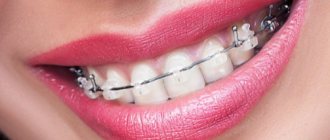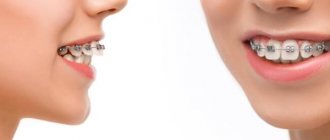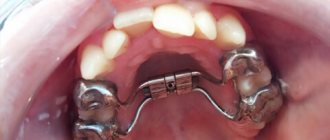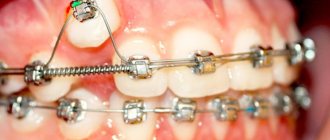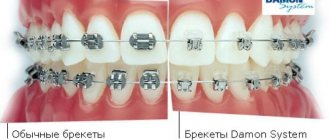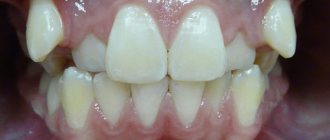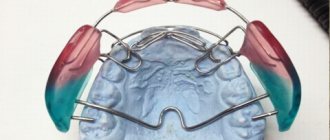If ten years ago someone had told you that wearing a device to correct your bite after forty years was normal, you would hardly have believed him. But today, more and more forty-year-old patients are resorting to such therapy, and one can even say that it has become fashionable.
Perhaps we should thank Madonna, Cindy Crawford, Gwen Stefani and other world-class superstars for this. Celebrities are increasingly appearing in public, proudly flaunting a smile adorned with braces. Some of them consciously prefer devices that attract attention.
Well, long live this fashion, because thanks to it, correcting the bite with braces after forty years is gaining momentum and helps maintain dental health in the second half of life. More and more people of this age can get the smile they have only dreamed of until now.
But the matter, of course, is not only about fashion coming from show business. Today, taking care of your health is a global trend. If earlier an orthodontic structure on the teeth of an adult caused surprise and could become the subject of jokes, today it only says that this person is seriously concerned about his health and image.
There is another important aspect due to which braces are becoming increasingly in demand by people in their fifties. We are talking about the manufacturing technologies of these devices and the process of their installation - they have become much more advanced and comfortable.
Braces today: installed faster, removed earlier
According to orthodontists, patients over the age of forty usually have characteristic doubts regarding treatment. They are concerned:
- how much do braces cost?
- how painful the therapy is;
- how long they will have to wear the braces.
A competent doctor will always try to dispel these doubts. At a consultation with an orthodontist, these doubts are completely dispelled. The doctor will tell you that the braces system causes inconvenience only in the first 2 weeks, until the patient adapts to them, and the treatment time depends on the complexity of the particular case. Today, the most minor problems with bite, such as mild crowding of teeth, can be solved in just 6-8 months. More severe cases may require removal of some molars and treatment for up to 30 months. But still, most often, orthodontic treatment takes 12-24 months, including orthodontic preparation, which is very relevant after 40 years, before rational prosthetics
Reasons to install braces after 40
Braces treatment is an investment in health and beauty. If at a young age the anomaly of malocclusion primarily disturbed the aesthetics of the face, then after 40 (perhaps even earlier) side pathologies appear in the body.
- Problems with diction are getting worse.
- As a result of uneven distribution of load between the dentition, the surface of the teeth is worn down. Defects, chips, and cracks form in the tooth enamel.
- An imbalance in the chewing load leads to inflammatory processes in the gums and carious formations on teeth that work beyond normal limits. The teeth decay and leave the jaw.
- The temporomandibular joint “wears out.” This provokes painful bursts, frequent crunching, clicking, tinkling. As people age, people with malocclusion are more likely to suffer from headaches and joint pain.
- The efficiency of chewing food decreases. Large particles of food are poorly digested and lead to the development of gastrointestinal pathologies.
- Prosthetics in perspective.
The most popular orthodontic systems
The world of orthodontics offers so many options for straightening the teeth that it can be difficult to understand them, but the experienced doctors of the “Full Order” clinic in St. Petersburg will be happy to help each patient make the right choice!
Because of its accuracy and predictability of treatment, patients love the insignia digital braces system. The fact is that such a device is not created on an assembly line, but for each patient individually, with preliminary silicone impressions of the patient’s jaw or digital scanning of the dentition. .
In pursuit of high aesthetics, many patients strive to correct their bite so that neither friends nor work colleagues notice the treatment. In this case, doctors may recommend that they use lingual braces. These brackets are attached to the teeth from the inside, so no one except the orthodontist and his patient will know about their existence.
It is impossible not to mention such traditional metal systems for correcting bites as the famous Daimon braces, which continue to be popular and give excellent results. Thanks to them, patients can forget about those bulky “pieces of iron” that people of past generations wore. Today's fixation techniques, together with the smaller size of the device, do their job: braces look much less bulky and are comfortable to wear.
Until recently, metal braces could only be seen on a child or teenager, and because of this, many adults feel that this device makes them look childish. But just look around and calm down: a huge number of mature people are treated by orthodontists!
It is necessary to say a few words about the Damon clear bracket system, whose advantages are transparency, the absence of ligatures and the good sliding of the arch due to this fact. Thanks to the latest quality, the treatment process is slightly accelerated, and the intervals between necessary visits to the clinic for planned activations increase. In this case, the patient can count on a faster and more convenient solution to his bite problems.
What should you prepare for mentally?
- Patients over 40 do not lack motivation, but they will certainly need patience. To form the correct bite, you will have to move and rotate your teeth, and to do this you will have to find free space in the jawbone. With a long-formed skeletal system, this will not be easy, and you may even have to remove one or two teeth.
- At the preparatory stage, you will have to engage in high-quality sanitation of the oral cavity: cure caries, improve gum health, and, if necessary, perform prosthetics or dental implants.
- Finally, you need to realize that at 40 years old, correction will take several times longer than at 15 years old.
There is no point in regretting that the bite was not corrected in a timely manner during adolescence. Even one and a half to two years will not be wasted. The investment of money and time will fully compensate for straight teeth and the self-confidence acquired with them. In addition, treatment at this age has certain advantages.
Patient reviews about treatment
Patients forty years and older who decided to correct their bite say that in the first days after installing braces, it seemed to them that all the eyes of those around them were focused only on their teeth. But later they noticed that no one paid attention to the orthodontic structure on their teeth, but their attitude towards their appearance changed for the better.
Other patients say they were worried about not being able to eat their favorite foods, but the fears were unfounded. Of course, they had to temporarily stop biting apples, gnawing nuts or enjoying Chinese noodles, which tended to entangle themselves with the installed braces, but in general they did not have to change their diet much.
That is why, with regard to correcting the bite after forty, we can draw the following conclusion: age does not matter when correcting the bite, since it is never too late to start taking care of your health and appearance!
The advantage of interacting with adult patients
Most often, children wear braces solely because of the wishes of their parents. Therefore, it can be quite difficult to convince them of the need for careful, daily care and diet. In addition, at this age there are no necessary self-discipline skills, which can cause many problems. As a result, after removing braces, children are diagnosed with extensive carious lesions or other pathologies, which can be quite difficult to correct even for the most experienced specialist.
Adults approach the issue of correcting their bite much more responsibly; they follow all the recommendations of their treating doctor. Most people over 40 are completely financially independent, so they can afford to install the most aesthetically attractive and comfortable structures made of ceramics or sapphire.
Such patients are mentally prepared for the upcoming difficulties and really want to achieve an excellent result. Adults are sincerely grateful to doctors who help them get a perfect smile.
previous post
Pain from braces
next entry
How long should you wear traction braces?
Rods are special rubber rings that are used for 4-5 months of treatment and are put on the structure separately. The main purpose is to enhance the thrust of the power arc. In this way, you can achieve faster and better results. It is noteworthy that, depending on the clinical case, different times are prescribed for how long these elastic bands should be worn during the day - in some cases they are placed only at night, and in others – around the clock.
The rods can be secured to the teeth in the following ways:
- on the upper and lower jaws on identical units;
- on four “square” – on 2 at the top and bottom;
- on three “triangles” - 2 on one jaw and 1 on the second;
- combining several of the methods described above at once.
The length of time to wear traction is determined individually. On average – from several months to six months.
Braces interfere with dental treatment
If during the period of bite correction the patient has a toothache, then treatment cannot be postponed. Eliminating one pathology and condoning another is an unacceptable approach for modern medicine.
The orthodontic system is non-removable when it comes to independent manipulations, but the orthodontist can easily partially disassemble the structure or even remove one of the plates.
After completing the treatment, the specialist performs reverse manipulations and re-sets the system.
Why do adults need braces and features of bite correction?
If you are already twenty, thirty or older, and you have come to terms with the deficiency, then should you contact an orthodontist? Modern dentistry gives a clear affirmative answer. If in youth, incorrect occlusion and crooked teeth brought only aesthetic dissatisfaction, then over the years factors can become the cause:
- Gastrointestinal diseases, metabolic disorders due to poor nutrition or insufficient grinding of food.
- Increasing displacement of the jaws affects the joints, arthritis or arthrosis develops, nerve endings are pinched, and headaches of unknown etiology appear.
- Changes in posture, further distortion of facial proportions.
But there are nuances that I always tell patients about during their first visit. Treatment with braces for adults lasts longer: the bone has already become stronger, and the teeth have confidently assumed the wrong position. Therefore, it will take more time to “move” problematic teeth. Sometimes it takes 1-2-3 years. But the aesthetic and functional result will stay with you for life and it’s worth it, believe me.
There are also features of correcting the bite and position of the teeth in adults: it may be necessary to remove wisdom teeth - this is necessary when the crowding of the teeth is great and there is not enough space for the placement of molars, incisors, and fangs.
Is it possible to do without braces?
One of the main reasons why many adults believe that their time for treatment has already passed is the reluctance to wear braces. Many people do not like metal structures visible on the teeth from an aesthetic point of view. There are also limitations with them, for example, not all dishes are convenient to eat. What if diction breaks down? Most patients get used to braces, but for some they still cause obvious inconvenience. And not only at the stage of addiction, but during the entire period of treatment.
You can do without braces - transparent invisible aligners have become an alternative. They are made of a polymer material about 0.3 mm thick according to the model of the patient's teeth. The patient puts on the aligners themselves - there is no need to install anything on the teeth. The time of wearing the aligners at the main stage of treatment is 22 hours a day, that is, they can be removed for only 2 hours in total - only for brushing your teeth and eating.
Aligners on teeth are almost invisible
Aligners work just as quickly as braces. The doctor calculates the treatment period in advance, since the computer model (setup) breaks the entire process of moving teeth into separate steps. In order for the treatment to proceed on time, the patient must strictly adhere to the schedule of wearing the aligners, but, as a rule, adults have no problems with this.
In general, treatment with aligners is easier: they are more comfortable than braces, they are easy to clean, and most importantly, they are completely invisible. Deciding on treatment has become much easier.
Other articles:
Success in a smile: how a correct bite affects self-esteem
10 problems due to malocclusion
How to reimburse tax for paid treatment
Reaching a new goal
Perhaps you are faced with a difficult choice: on the one hand, you are embarrassed about your smile, on the other, you do not want to wear braces for 1 to 3 years. But the faster you start, the faster you finish. As they say, the best time to do this is yesterday, the second best time is today. Moreover, you will experience great joy as you systematically move towards your goal, seeing how your teeth are straightened month after month, and in the end you will get the long-awaited result - a beautiful smile. This experience will certainly be useful in other areas of life.
Specifics of treatment with braces in adults
Adult patients should keep in mind that it is often necessary to remove teeth to achieve a high-quality result of orthodontic treatment. This does not mean that every patient needs it; removal is carried out only in cases where there is not enough space to restore the normal position of the teeth. Foreign orthodontists change the jaw size of adults using surgery. In Russia, orthognathic surgery is not yet particularly widespread due to the fact that our patients are extremely reluctant to agree to undergo operations. Let us repeat that this is just information about how it might be. In most cases, orthodontic treatment for adults is limited to simply installing braces.
